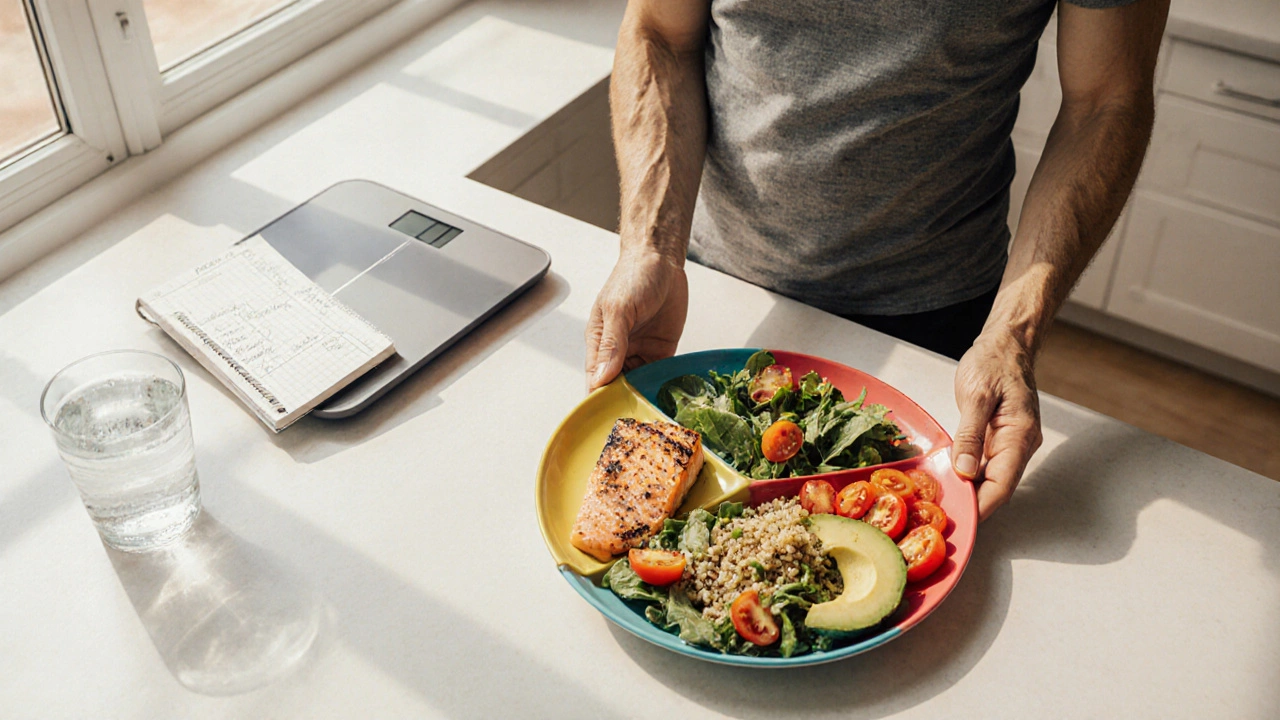Weight Loss Calculator After 50
How This Calculator Works
Based on the article's recommendations for safe weight loss after 50, this tool calculates your daily calorie target and protein needs to lose 20 pounds in 12-16 weeks (1-1.5 lb/week).
Your Weight Loss Plan
Your Personalized Weight Loss Plan
Your Daily Calorie Target:
Your Daily Protein Target:
Estimated Time to Lose 20 Pounds:
Recommended: Maintain a calorie deficit of 500-750 kcal daily while consuming 0.45-0.55 g of protein per pound of body weight to protect muscle mass and maximize fat loss.
lose weight after 50 is possible, but it takes a mix of science‑backed habits and realistic expectations. Below is a no‑fluff guide that walks you through the why, what, and how of shedding 20 pounds safely and quickly once you’ve crossed the half‑century mark.
Quick Takeaways
- Aim for a daily calorie deficit of 500‑750kcal to lose 1‑1.5lb per week.
- Prioritize protein intake (1.0‑1.2g perlb of lean mass) to protect muscle.
- Combine 2‑3 days of resistance training with 2‑3 days of high‑intensity interval training (HIIT) for maximum fat burn.
- Sleep7‑9hours nightly and manage stress; both heavily influence metabolism in your 50s.
- Consider a reputable medical weight loss clinic for personalized monitoring and, if needed, safe bariatric options.
Understanding the Challenge After 50
When you turn 50, two biological shifts start to bite:
- Basal metabolic rate drops by roughly 5‑10% every decade, meaning you burn fewer calories at rest.
- Hormonal changes-declining testosterone in men and reduced estrogen in women-can increase visceral fat storage.
These factors make the old “eat less, move more” mantra less straightforward. The key is to compensate for the slower metabolism with smarter nutrition and targeted exercise while preserving lean muscle.
Core Principle: Create a Sustainable Calorie Deficit
Weight loss fundamentally follows the equation energy out>energy in. For a 20‑pound goal, you need a total deficit of about 70,000kcal (since 1lb ≈ 3,500kcal). Splitting that over 12‑16weeks yields a daily deficit of 500‑750kcal.
How to achieve it without feeling starving:
- Track your intake for the first week using a free app. Knowing your baseline makes adjustments accurate.
- Swap high‑calorie liquids (sodas, sugary coffee) for water, herbal tea, or black coffee.
- Replace refined carbs with fiber‑rich veggies; they fill you up while adding minimal calories.
- Increase protein intake to keep hunger at bay and support muscle preservation.
Fueling with Protein: The Muscle‑Sparing Secret
Older adults lose muscle faster-a process called sarcopenia. Each gram of protein burns about 4‑5kcal through the thermic effect of food, giving a tiny extra calorie burn while protecting lean mass.
Target 0.45‑0.55g perlb of body weight each day. For a 180‑lb person, that’s roughly 80‑100g of protein, which can be split across meals:
- Breakfast: 20g (Greek yogurt + berries)
- Lunch: 25g (grilled chicken salad)
- Dinner: 30g (baked salmon + quinoa)
- Snack: 15g (cottage cheese or a protein shake)
Animal sources provide complete amino acid profiles, but high‑quality plant sources (lentils, tofu, tempeh) work just as well when combined.

Move Smart: Resistance Training & HIIT
Exercise after 50 should focus on two goals: keep muscle and spike the post‑exercise calorie burn.
Resistance Training
Lift moderate weights (8‑12rep range) 2‑3 times a week. Compound moves-squats, deadlifts, push‑ups, rows-engage multiple muscle groups and stimulate the greatest hormonal response.
High‑Intensity Interval Training (HIIT)
Short bursts of 30‑60seconds at 80‑90% max effort followed by 60‑90seconds of low‑intensity recovery. A 20‑minute session burns as many calories as a 45‑minute steady‑state cardio session, and the after‑burn (EPOC) can last up to 24hours.
Sample weekly split:
- Monday - Resistance (upper body)
- Tuesday - HIIT (treadmill or bike)
- Wednesday - Rest or gentle yoga
- Thursday - Resistance (lower body)
- Friday - HIIT (body‑weight circuit)
- Saturday - Light walk or active recreation
- Sunday - Rest
Sleep & Stress: Hidden Saboteurs
Both sleep deprivation and chronic stress elevate cortisol, which encourages the body to store fat around the abdomen.
Practical steps:
- Set a consistent bedtime, aiming for 7‑9hours.
- Limit screen exposure 30minutes before sleep; use blue‑light filters.
- Incorporate a wind‑down routine-stretching, breathing, or reading.
- Practice stress‑relief techniques daily: 10‑minute mindfulness, brisk walks, or hobby time.
Professional Support: Clinics & When to Consider Surgery
While many achieve the 20‑pound target on their own, a medical weight loss clinic adds value through:
- Baseline labs (thyroid, hormones, vitamin D) that reveal hidden barriers.
- Personalized nutrition plans calibrated to your BMR and activity level.
- Prescription‑grade appetite suppressants or GLP‑1 agonists for those who need a pharmacologic nudge.
If diet, exercise, and medication still leave you stuck above 10% body‑fat, discuss bariatric surgery options (e.g., sleeve gastrectomy) with a board‑certified bariatric surgeon. It’s a safe, minimally invasive route for individuals with BMI≥35kg/m² or BMI≥30kg/m² with obesity‑related comorbidities.
Sample 8‑Week Plan to Lose 20lb
Below is a concrete template you can adapt. It assumes a starting weight of 190lb, BMR≈1,600kcal, and a daily target intake of 1,300kcal.
| Week | Daily Calories | Protein (g) | Exercise Focus | Projected Weekly Loss |
|---|---|---|---|---|
| 1‑2 | 1,300 | 95 | Resistance + 2HIIT sessions | 1‑1.5lb |
| 3‑4 | 1,250 | 100 | Resistance + 3HIIT sessions | 1‑1.5lb |
| 5‑6 | 1,200 | 105 | Resistance + 3HIIT + 1steady‑state cardio | 1‑2lb |
| 7‑8 | 1,150 | 110 | Resistance + 2HIIT + active recreation | 1‑2lb |
Track progress weekly with a scale, tape measure, and photos. Adjust calories by ±50kcal if weight stalls for two consecutive weeks.
Checklist for Success
- ✅ Calculate your maintenance calories using a reliable calculator.
- ✅ Set a daily deficit of 500‑750kcal.
- ✅ Aim for 80‑110g of protein each day.
- ✅ Schedule 2‑3 resistance sessions and 2‑3 HIIT sessions per week.
- ✅ Prioritize 7‑9hours of sleep.
- ✅ Use stress‑relief tools daily.
- ✅ Book an initial consult at a reputable medical weight loss clinic for labs and personalized advice.
Frequently Asked Questions
Is losing 20lb fast safe for someone over 50?
A loss of 1‑1.5lb per week is generally safe and maintains muscle mass when protein is sufficient and resistance training is included. Faster rates increase the risk of nutrient deficiencies and muscle loss.
What’s the role of intermittent fasting in this plan?
IF can simplify calorie control and improve insulin sensitivity, but it’s optional. If you choose a 16:8 window, just keep the same macro targets within the eating period.
Can I skip cardio and still lose the weight?
Yes, as long as you maintain a calorie deficit and do resistance training. Cardio (including HIIT) accelerates calorie burn and heart health, so it’s a valuable addition.
When should I consider a bariatric procedure?
If BMI≥35kg/m² with health issues (type2diabetes, hypertension) or BMI≥30kg/m² with severe obesity that hasn’t responded to diet, exercise, and medication after 6‑12months, discuss surgery with a qualified bariatric surgeon.
How do I handle plateaus?
Re‑evaluate your calorie intake (maybe reduce by another 50kcal), increase protein, add a new resistance exercise, or incorporate a short diet break of 1‑2 weeks at maintenance calories before resuming the deficit.

 Understanding How Quickly Herbal Supplements Take Effect in Your Body
Understanding How Quickly Herbal Supplements Take Effect in Your Body
 Essential Annual Blood Tests for Optimal Health
Essential Annual Blood Tests for Optimal Health
 Complimentary Health Check-Up: Meaning, Inclusions, Benefits, and How to Use It (India 2025)
Complimentary Health Check-Up: Meaning, Inclusions, Benefits, and How to Use It (India 2025)
 Can Prescription Drugs Be Ordered Online? Your Guide to Online Pharmacies
Can Prescription Drugs Be Ordered Online? Your Guide to Online Pharmacies
 How to Choose the Best Herbal Supplements: Expert Tips for Safe Buying
How to Choose the Best Herbal Supplements: Expert Tips for Safe Buying